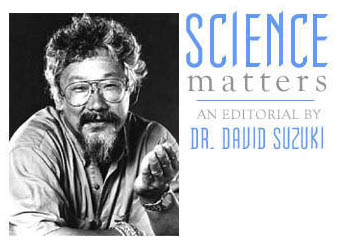 "Higher
levels of flame retardants found in farmed salmon" read the headlines a
few weeks ago. While the news raised questions about the safety of eating
farmed fish, the bigger question might be: why the heck are there flame
retardants in salmon at all?
"Higher
levels of flame retardants found in farmed salmon" read the headlines a
few weeks ago. While the news raised questions about the safety of eating
farmed fish, the bigger question might be: why the heck are there flame
retardants in salmon at all?
And farmed salmon aren't the only contaminated fish. According to recent
figures released by the Environmental Protection Agency (EPA) in the United
States, one-third of all lakes in the United States and one-quarter of all
rivers are contaminated with mercury or other pollutants to the point that
people should not eat fish caught from them.
What's going on here? Well, it all goes back to a very simple but often
forgotten point. In nature, everything is connected to everything else through
air, water, food, and energy. So when we create chemical compounds that do not
readily break down in nature, it should be no surprise that they start
appearing in even the most far-flung corners of the Earth.
In the most recent case with farmed salmon, the culprit chemical compound is
polybrominated diphenyl ethers (PBDEs), used widely as flame retardants in
furniture and electronic goods. They are released into the environment when
they are produced but also through everyday wear and tear on the products that
contain them.
The problem with PBDEs is that they are similar in structure to PCBs, which
are linked to cancer and damage to the immune and reproductive systems.
PBDEs are not as well studied but have also been linked to impaired learning
and development. And while PCBs have been phased out and are slowly declining
in the environment, PBDEs are increasing. In fact, levels of PBDE in human
blood have doubled in less than a decade.
Persistent chemicals like PCBs and PBDEs disperse readily throughout the
environment and tend to concentrate in the food chain through a process called
"bioaccumulation," so animals higher up the food chain tend to be
more contaminated.
That's the problem with salmon — especially farmed salmon. Salmon
are carnivores, and farmed salmon are fed concentrated oily pellets made from
ground-up other fish. Wild salmon, meanwhile, generally have a lower fat diet
of creatures lower on the food chain, so contaminants generally accumulate in
them less readily.
Mercury is another toxin that can pose a significant health risk, especially
to pregnant women and young children. The recent EPA survey that showed
widespread mercury contamination in freshwater fish is nothing new.
Surveys conducted since 1993 have consistently shown high levels of
contamination in North America. Many commercial saltwater fish, such as
swordfish and some tuna, can also contain dangerously high levels of mercury.
So with all these contamination concerns, should people just avoid eating
fish? Not necessarily. Oily fish contain healthy omega-3 fatty acids.
Instead of avoiding fish altogether, a better step would be to learn which
fish are the least contaminated and which fish are grown or caught in a
sustainable manner. Those species are a consumer's best bet.
But trying to avoid hazardous chemicals that are persistent and ubiquitous in
the environment is not really an answer either. While contaminants like
mercury and PBDE may concentrate in fish, they are actually found throughout
the food chain. Eliminating them is the only real long-term answer.
So far, the European Union has banned two types of PBDEs, and California will
ban them as of 2008. But Canada currently has no plan to eliminate them. And
although mercury emissions have fallen substantially in the last decade, this
toxin also continues to persist in the environment.
One of the key culprits is coal-fired power plants, which are also a major
contributor to the heat-trapping gases that cause climate change.
Given the hazards of these chemicals and their persistence once released into
the environment, governments should be seeking to eliminate them at the
source, rather than putting the onus on citizens to seek out the least
dangerous options in a contaminated world.
Related Link
Take the Nature Challenge and learn more at www.davidsuzuki.org.